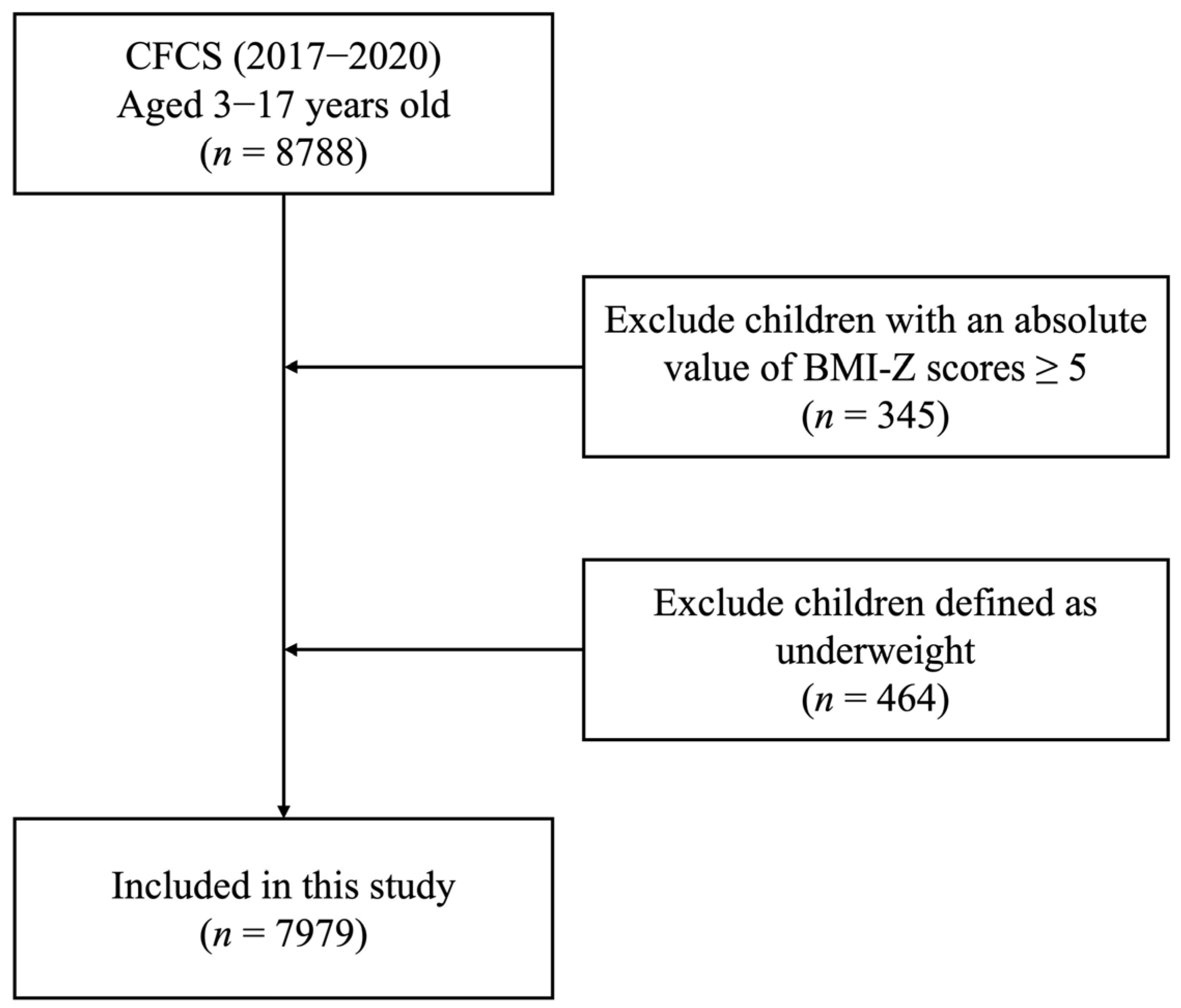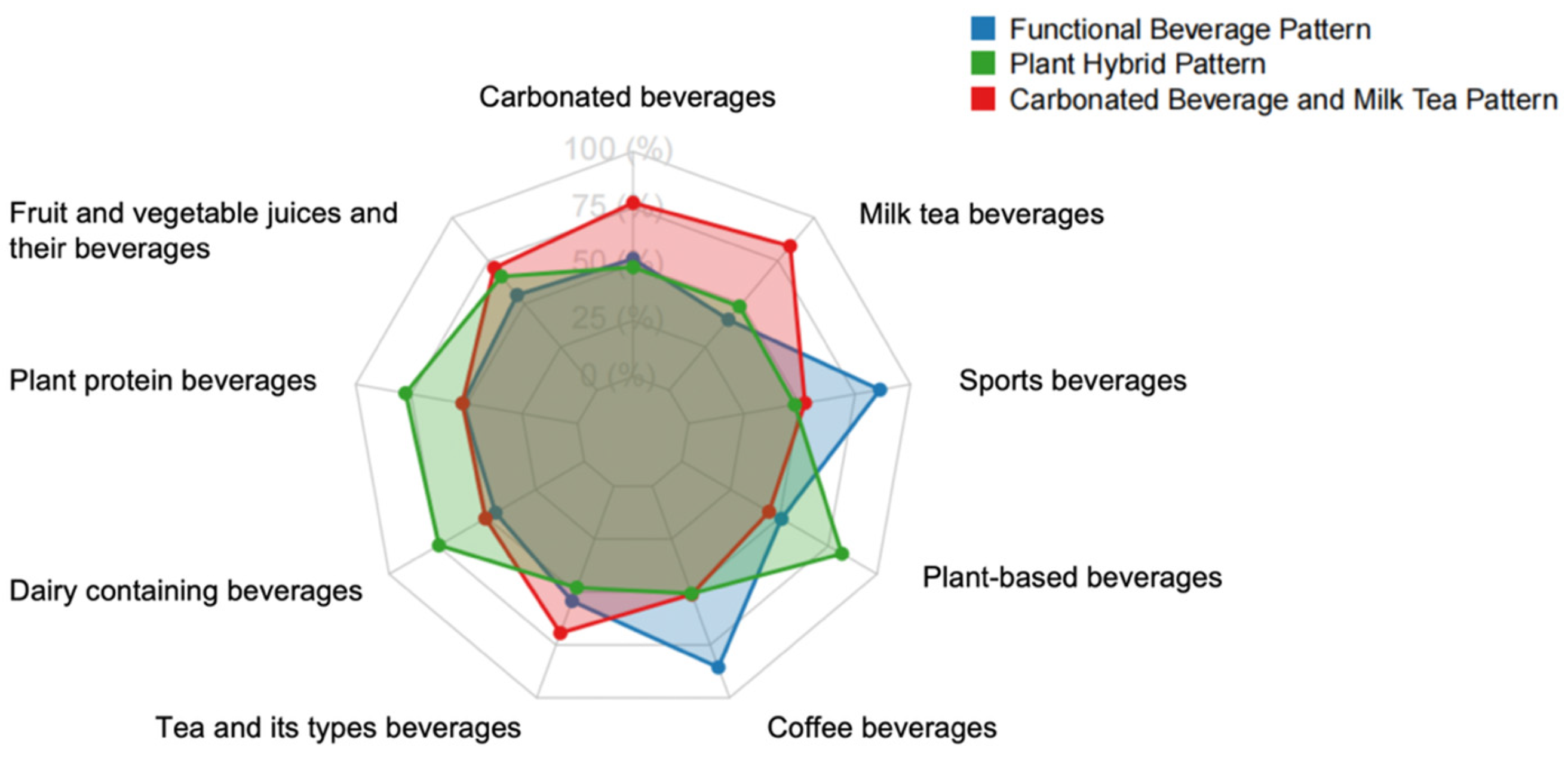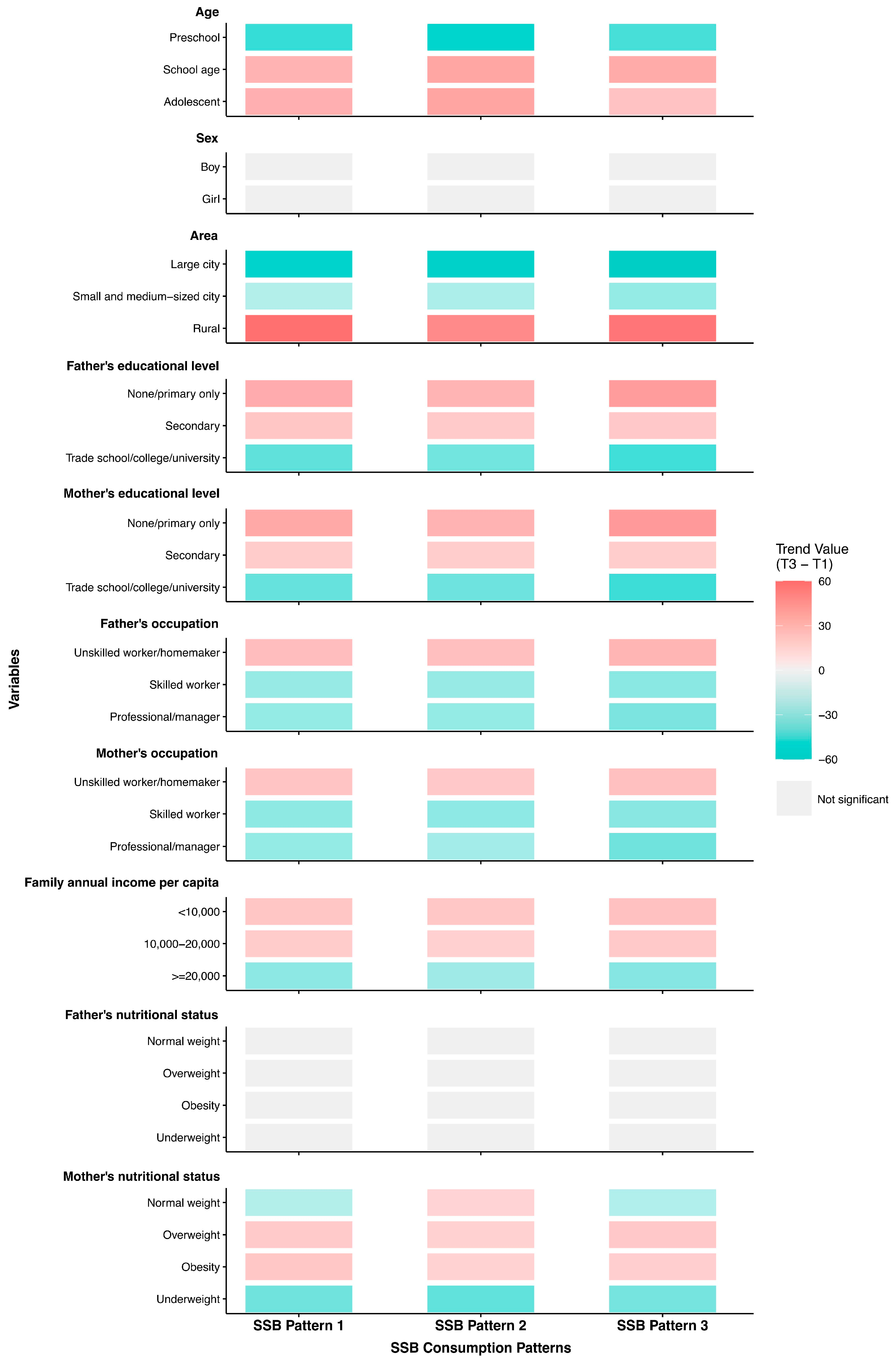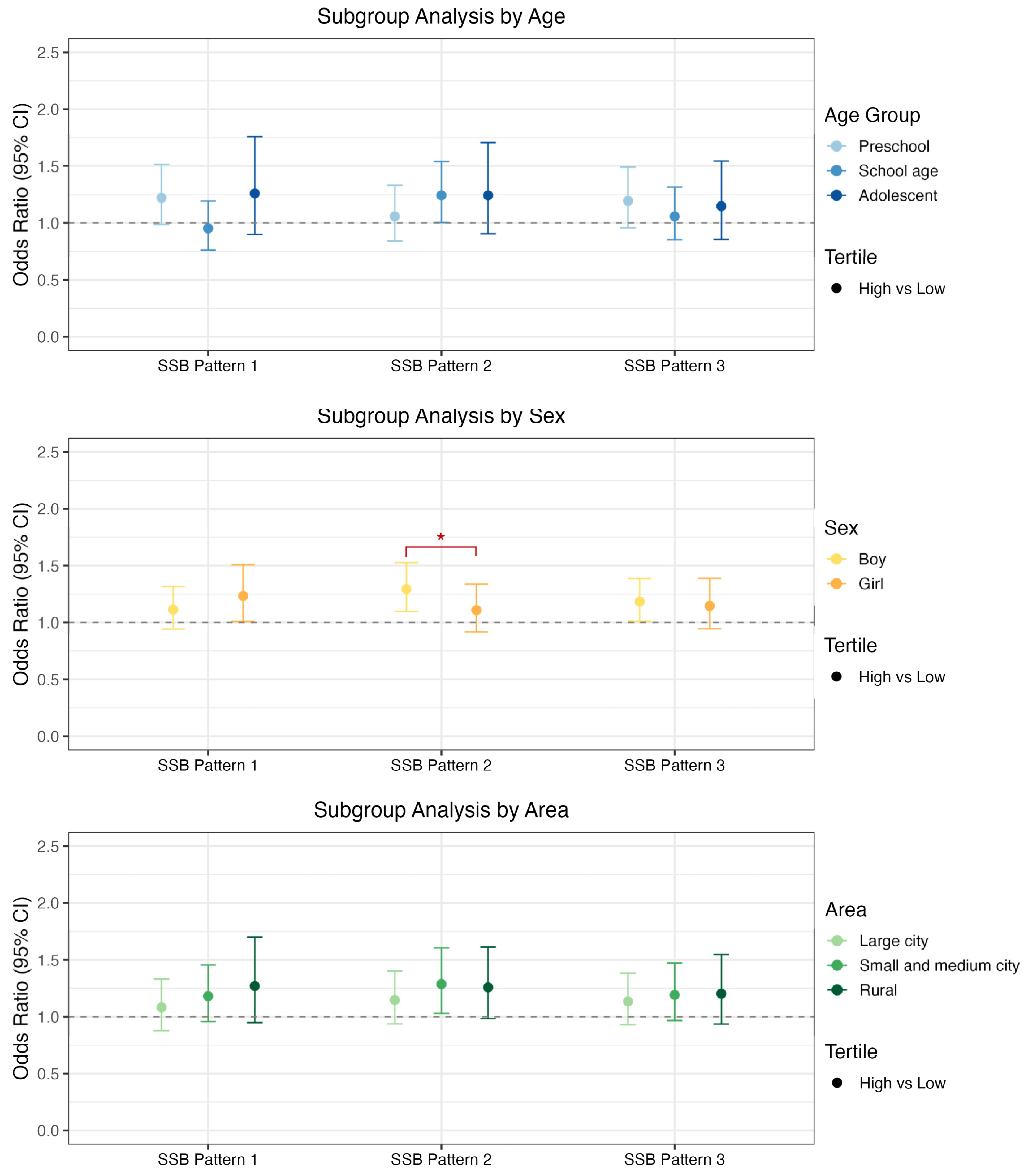The Association of Sugar-Sweetened Beverages Consumption Patterns and Overweight/Obesity: Evidence from a Large-Scale Survey of Chinese Children and Adolescents
Abstract
1. Introduction
2. Methods
2.1. Study Design and Participants
2.2. SSB Consumption Measurement and Patterns Construction
2.3. The Criteria for Diagnosing Childhood Overweight/Obesity
2.4. Covariates
2.5. Statistical Analysis
3. Results
3.1. Participants Characteristics
3.2. SSB Consumption Patterns Identification and Characteristics of Study Participants
3.3. The Association Between SSB Consumption Patterns and Childhood Overweight/Obesity
3.4. Subgroup Analysis of SSB Consumption Patterns and Childhood Overweight/Obesity Across Different Age, Sex, and Area
3.5. Sensitivity Analysis
4. Discussion
5. Conclusions
Supplementary Materials
Author Contributions
Funding
Institutional Review Board Statement
Informed Consent Statement
Data Availability Statement
Conflicts of Interest
Abbreviations
| BMI | body mass index |
| CIs | confidence intervals |
| CFCS | Chinese Food Consumption Survey |
| IQR | interquartile range |
| KMO | Kaiser-Meyer-Olkin |
| LRTs | likelihood ratio tests |
| OR | odds ratio |
| PPS | Probability Proportional to Size |
| SD | standard deviation |
| SSBs | sugar-sweetened beverages |
| WHO | World Health Organization |
References
- World Health Organization (WHO). Obesity and Overweight. Available online: https://www.who.int/news-room/fact-sheets/detail/obesity-and-overweight (accessed on 1 August 2025).
- World Health Organization. Levels and Trends in Child Malnutrition: UNICEF/WHO/World Bank Group Joint Child Malnutrition Estimates: Key Findings of the 2025 Edition. Available online: https://www.who.int/publications/i/item/9789240112308 (accessed on 4 September 2025).
- The State Council Information Office of the People’s Republic of China. Press Briefing for the Report on Chinese Residents’ Chronic Diseases and Nutrition. Available online: https://www.gov.cn/xinwen/2020-12/24/content_5572983.htm (accessed on 8 July 2025).
- Song, X.; Zhou, B.; Baird, S.; Lu, C.; Ezzati, M.; Chen, L.; Liu, J.; Zhang, Y.; Wang, R.; Ma, Q.; et al. Trends and inequalities in thinness and obesity among Chinese children and adolescents: Evidence from seven national school surveys between 1985 and 2019. Lancet Public Health 2024, 9, e1025–e1036. [Google Scholar] [CrossRef]
- Lara-Castor, L.; Micha, R.; Cudhea, F.; Miller, V.; Shi, P.; Zhang, J.; Sharib, J.R.; Erndt-Marino, J.; Cash, S.B.; Barquera, S.; et al. Intake of sugar sweetened beverages among children and adolescents in 185 countries between 1990 and 2018: Population based study. BMJ 2024, 386, e079234. [Google Scholar] [CrossRef]
- Liu, X.T.; Wang, Y.D.; Xu, Y.J.; Wang, X.Y.; Shan, S.F.; Xiong, J.Y.; Cheng, G. The divergent association of diet intake, parental education, and nutrition policy with childhood overweight and obesity from low- to high-income countries: A meta-analysis. J. Glob. Health 2024, 14, 04215. [Google Scholar] [CrossRef]
- Tang, N.; Li, J.; Zhang, Z. Associations between sugar-sweetened beverage consumption, moderate-to-vigorous physical activity duration and psychological symptoms in adolescents: A nationwide study in China. J. Affect. Disord. 2025, 380, 26–36. [Google Scholar] [CrossRef]
- Yan, R.; Gong, E.; Li, X.; Zheng, L.; Liao, W.; Min, K.; Su, F.; Wang, L.; Wang, J.; Hu, D.; et al. Impact of Obesogenic Environments on Sugar-Sweetened Beverage Consumption among Preschoolers: Findings from a Cross-Sectional Survey in Beijing. Nutrients 2022, 14, 2860. [Google Scholar] [CrossRef]
- Fan, Z.; Shi, T.; Yang, Y.; He, W.; Chai, D. Associations of sugar-sweetened beverage consumption and screen time with physical fitness index: A multicentre cross-sectional study among Chinese adolescents. BMC Public Health 2024, 24, 2656. [Google Scholar] [CrossRef]
- Dos Santos Leal, K.; Pinto da Costa, M.; Vilela, S. Socioeconomic and household framework influences in school-aged children’s eating habits: Understanding the parental roles. Appetite 2024, 201, 107605. [Google Scholar] [CrossRef] [PubMed]
- Fismen, A.S.; Buoncristiano, M.; Williams, J.; Helleve, A.; Abdrakhmanova, S.; Bakacs, M.; Bergh, I.H.; Boymatova, K.; Duleva, V.; Fijalkowska, A.; et al. Socioeconomic differences in food habits among 6- to 9-year-old children from 23 countries-WHO European Childhood Obesity Surveillance Initiative (COSI 2015/2017). Obes. Rev. 2021, 22 (Suppl. S6), e13211. [Google Scholar] [CrossRef]
- Gan, Q.; Xu, P.; Yang, T.; Cao, W.; Xu, J.; Li, L.; Pan, H.; Zhao, W.; Zhang, Q. Sugar-Sweetened Beverage Consumption Status and Its Association with Childhood Obesity among Chinese Children Aged 6–17 Years. Nutrients 2021, 13, 2211. [Google Scholar] [CrossRef] [PubMed]
- Zhuang, X.; Liu, Y.; Gittelsohn, J.; Lewis, E.; Song, S.; Ma, Y.; Wen, D. Sugar-Sweetened Beverages Consumption and Associated Factors among Northeastern Chinese Children. Nutrients 2021, 13, 2233. [Google Scholar] [CrossRef]
- Yu, L.; Zhou, H.; Zheng, F.; Song, J.; Lu, Y.; Yu, X.; Zhao, C. Sugar Is the Key Cause of Overweight/Obesity in Sugar-Sweetened Beverages (SSB). Front. Nutr. 2022, 9, 885704. [Google Scholar] [CrossRef]
- Guo, J.; Luo, S.; Su, Z.; Fu, J.; Ma, J.; Zhong, X.; Zeng, C.; Huang, J.; Zhang, W.; Zhang, Z.; et al. Consumption Patterns of Sugar-Sweetened Beverages and Association with Undernutrition among Children Aged 9–17 Years in Guangzhou, China: A Cross-Sectional Study. Nutrients 2024, 16, 650. [Google Scholar] [CrossRef]
- Te Morenga, L.; Mallard, S.; Mann, J. Dietary sugars and body weight: Systematic review and meta-analyses of randomised controlled trials and cohort studies. BMJ 2012, 346, e7492. [Google Scholar] [CrossRef]
- (GB/T 10789-2015); General Standard for Beverage. The General Administration of Quality Supervision, Inspection and Quarantine of the People’s Republic of China, and The Standardization Administration of China: Beijing, China, 2015.
- Reijer, A.H.J.d.; Otter, P.W.; Jacobs, J.P.A.M. An heuristic scree plot criterion for the number of factors. Stat. Pap. 2024, 65, 3991–4000. [Google Scholar] [CrossRef]
- World Health Organization. Child Growth Standards. Available online: https://www.who.int/tools/child-growth-standards (accessed on 11 July 2025).
- Growth Reference Data for 5–19 Years. Available online: https://www.who.int/tools/growth-reference-data-for-5to19-years (accessed on 11 July 2025).
- Council, S. Notice of the State Council on Adjusting the Standards for Classifying Urban Sizes. Available online: https://www.gov.cn/zhengce/content/2014-11/20/content_9225.htm (accessed on 11 July 2025).
- Zhu, Y.; Wang, Y.; Shrikant, B.; Tse, L.A.; Zhao, Y.; Liu, Z.; Wang, C.; Xiang, Q.; Rangarajan, S.; Li, S.; et al. Socioeconomic disparity in mortality and the burden of cardiovascular disease: Analysis of the Prospective Urban Rural Epidemiology (PURE)-China cohort study. Lancet Public Health 2023, 8, e968–e977. [Google Scholar] [CrossRef] [PubMed]
- National Health Commission of the People’s Republic of China. Notice of the General Office of the National Health Commission on the Issuance of the Guidelines for the Diagnosis and Treatment of Obesity (2024 Edition). Available online: https://www.gov.cn/zhengce/zhengceku/202410/content_6981734.htm#:~:text=%E4%B8%BA%E8%BF%9B%E4%B8%80%E6%AD%A5%E6%8F%90%E9%AB%98%E8%82%A5%E8%83%96,024%E5%B9%B4%E7%89%88%EF%BC%89%E3%80%8B%E3%80%82 (accessed on 12 July 2025).
- Zhang, X.; Wu, S.; Lu, Y.; Qi, J.; Li, X.; Gao, S.; Qi, X.; Tan, J. Association of ambient PM(2.5) and its components with in vitro fertilization outcomes: The modifying role of maternal dietary patterns. Ecotoxicol. Environ. Saf. 2024, 282, 116685. [Google Scholar] [CrossRef] [PubMed]
- Aghayan, M.; Asghari, G.; Yuzbashian, E.; Mahdavi, M.; Mirmiran, P.; Azizi, F. Secular trend in dietary patterns of Iranian adults from 2006 to 2017: Tehran lipid and glucose study. Nutr. J. 2020, 19, 110. [Google Scholar] [CrossRef]
- Research, I. Consumer Insights Analysis of China’s Sugar-Free Beverage Industry in 2024: Sugar-Free Tea Drinks Become the Mainstream of Consumption, with Taste and Effectiveness Being the Key Concerns. Available online: https://www.iimedia.cn/c1020/101814.html (accessed on 28 July 2025).
- Rao, M.; Afshin, A.; Singh, G.; Mozaffarian, D. Do healthier foods and diet patterns cost more than less healthy options? A systematic review and meta-analysis. BMJ Open 2013, 3, e004277. [Google Scholar] [CrossRef]
- Lehto, E.; Ray, C.; Te Velde, S.; Petrova, S.; Duleva, V.; Krawinkel, M.; Behrendt, I.; Papadaki, A.; Kristjansdottir, A.; Thorsdottir, I.; et al. Mediation of parental educational level on fruit and vegetable intake among schoolchildren in ten European countries. Public Health Nutr. 2015, 18, 89–99. [Google Scholar] [CrossRef]
- You, L.; Yang, T.; Li, Z.; Xue, Y.; Shao, X.; Wang, P.; Zhang, Y. Consumption pattern of liquid dairy products and soft beverages among preschool children in nine areas of China. Chin. J. Public Health 2016, 32, 420–424. [Google Scholar] [CrossRef]
- Silva, P. Food and Nutrition Literacy: Exploring the Divide between Research and Practice. Foods 2023, 12, 2751. [Google Scholar] [CrossRef] [PubMed]
- Zeng, M.; Zhu, Y.; Cai, Z.; Xian, J.; Li, S.; Wang, T.; Shi, Z.; Sharma, M.; Zhao, Y. Nutrition Literacy of Middle School Students and Its Influencing Factors: A Cross-Sectional Study in Chongqing, China. Front. Public Health 2022, 10, 807526. [Google Scholar] [CrossRef]
- Li, S.; Zhu, Y.; Zeng, M.; Li, Z.; Zeng, H.; Shi, Z.; Zhao, Y. Association Between Nutrition Literacy and Overweight/Obesity of Adolescents: A Cross-Sectional Study in Chongqing, China. Front. Nutr. 2022, 9, 893267. [Google Scholar] [CrossRef] [PubMed]
- Egg, S.; Wakolbinger, M.; Reisser, A.; Schatzer, M.; Wild, B.; Rust, P. Relationship between nutrition knowledge, education and other determinants of food intake and lifestyle habits among adolescents from urban and rural secondary schools in Tyrol, Western Austria. Public Health Nutr. 2020, 23, 3136–3147. [Google Scholar] [CrossRef] [PubMed]
- Shi, Z.; Song, Z.; Song, Q.; Qu, M.; Wang, Z.; Zang, J. Nutrient content of 122 kinds of retail handcrafted milk tea products in Shanghai. J. Environ. Occup. Med. 2023, 40, 756–760. [Google Scholar] [CrossRef]
- Sugajski, M.; Buszewska-Forajta, M.; Buszewski, B. Functional Beverages in the 21st Century. Beverages 2023, 9, 27. [Google Scholar] [CrossRef]
- Irwin, C.; Khalesi, S.; Desbrow, B.; McCartney, D. Effects of acute caffeine consumption following sleep loss on cognitive, physical, occupational and driving performance: A systematic review and meta-analysis. Neurosci. Biobehav. Rev. 2020, 108, 877–888. [Google Scholar] [CrossRef]
- Malik, V.S.; Hu, F.B. The role of sugar-sweetened beverages in the global epidemics of obesity and chronic diseases. Nat. Rev. Endocrinol. 2022, 18, 205–218. [Google Scholar] [CrossRef]




| Variables | Total (n = 7979) | Normal Weight (n = 5397) | Overweight (n = 1585) | Obesity (n = 997) |
|---|---|---|---|---|
| Age in years, mean ± SD | 9.10 ± 3.93 | 9.45 ± 4.05 | 8.71 ± 3.70 | 7.87 ± 3.25 |
| Age in years, median (IQR) | 9.0 (6.0) | 9.0 (7.0) | 9.0 (6.0) | 8.0 (5.0) |
| Age, n (%) | ||||
| Preschool | 2479 (31.1) | 1588 (29.4) | 514 (32.4) | 377 (37.8) |
| School age | 3161 (39.6) | 1992 (36.9) | 694 (43.8) | 475 (47.6) |
| Adolescent | 2339 (29.3) | 1817 (33.7) | 377 (23.8) | 145 (14.5) |
| Sex, n (%) | ||||
| Boy | 4168 (52.2) | 2603 (48.2) | 911 (57.5) | 654 (65.6) |
| Girl | 3811 (47.8) | 2794 (51.8) | 674 (42.5) | 343 (34.4) |
| Area, n (%) | ||||
| Large city | 2252 (28.2) | 1457 (27.0) | 498 (31.4) | 297 (29.8) |
| Small and medium sized city | 2584 (32.4) | 1768 (32.8) | 496 (31.3) | 320 (32.1) |
| Rural | 3143 (39.4) | 2172 (40.2) | 591 (37.3) | 380 (38.1) |
| Father’s educational level, n (%) | ||||
| None or primary only | 714 (8.9) | 481 (8.9) | 131 (8.3) | 102 (10.2) |
| Secondary | 3803 (47.7) | 2576 (47.7) | 747 (47.1) | 480 (48.1) |
| Trade school/college/university | 1888 (23.7) | 1261 (23.4) | 404 (25.5) | 223 (22.4) |
| NA | 1574 (19.7) | 1079 (20.0) | 303 (19.1) | 192 (19.3) |
| Mother’s educational level, n (%) | ||||
| None or primary only | 1364 (17.1) | 950 (17.6) | 243 (15.3) | 171 (17.2) |
| Secondary | 3964 (49.7) | 2662 (49.3) | 815 (51.4) | 487 (48.8) |
| Trade school/college/university | 1925 (24.1) | 1294 (24.0) | 387 (24.4) | 244 (24.5) |
| NA | 726 (9.1) | 491 (9.1) | 140 (8.8) | 95 (9.5) |
| Father’s occupation, n (%) | ||||
| Unskilled worker or homemaker | 2791 (35.0) | 1902 (35.2) | 528 (33.3) | 361 (36.2) |
| Skilled worker | 1982 (24.8) | 1294 (24.0) | 425 (26.8) | 263 (26.4) |
| Professional/manager | 1632 (20.5) | 1122 (20.8) | 329 (20.8) | 181 (18.2) |
| NA | 1574 (19.7) | 1079 (20.0) | 303 (19.1) | 192 (19.3) |
| Mother’s occupation, n (%) | ||||
| Unskilled worker or homemaker | 4297 (53.9) | 2931 (54.3) | 839 (52.9) | 527 (52.9) |
| Skilled worker | 1781 (22.3) | 1162 (21.5) | 378 (23.8) | 241 (24.2) |
| Professional/manager | 1175 (14.7) | 813 (15.1) | 228 (14.4) | 134 (13.4) |
| NA | 726 (9.1) | 491 (9.1) | 140 (8.8) | 95 (9.5) |
| Family annual income per capita, n (%) | ||||
| <10,000 | 2458 (30.81) | 1712 (31.7) | 441 (27.8) | 305 (30.6) |
| ≥10,000–20,000 | 3057 (38.31) | 2074 (38.4) | 607 (38.3) | 376 (37.7) |
| ≥20,000 | 2464 (30.88) | 1611 (29.8) | 537 (33.9) | 316 (31.7) |
| Father’s BMI, mean ± SD | 24.30 ± 3.26 | 24.05 ± 3.16 | 24.69 ± 3.31 | 24.97 ± 3.54 |
| Father’s nutritional status, n (%) | ||||
| Normal weight | 3067 (38.4) | 2186 (40.5) | 559 (35.3) | 322 (32.3) |
| Overweight | 2429 (30.4) | 1600 (29.6) | 194 (12.2) | 148 (14.8) |
| Obesity | 770 (9.7) | 428 (7.9) | 509 (32.1) | 320 (32.1) |
| Underweight | 139 (1.7) | 104 (1.9) | 20 (1.3) | 15 (1.5) |
| NA | 1574 (19.7) | 1079 (20.0) | 303 (19.1) | 192 (19.3) |
| Mother’s BMI, mean ± SD | 23.30 ± 3.25 | 23.02 ± 3.14 | 23.70 ± 3.28 | 24.20 ± 3.53 |
| Mother’s nutritional status, n (%) | ||||
| Normal weight | 4248 (58.6) | 3018 (55.9) | 785 (49.5) | 445 (44.6) |
| Overweight | 2076 (28.6) | 328 (6.1) | 149 (9.4) | 127 (12.7) |
| Obesity | 604 (8.3) | 1310 (24.3) | 459 (29.0) | 307 (30.8) |
| Underweight | 325 (4.5) | 250 (4.6) | 52 (3.3) | 23 (2.3) |
| NA | 726 (9.1) | 491 (9.1) | 140 (8.8) | 95 (9.5) |
| Variable a | Carbonated Beverage and Milk Tea Pattern | p | Functional Beverage Pattern | p | Plant Hybrid Pattern | p | |||
|---|---|---|---|---|---|---|---|---|---|
| T1 | T3 | T1 | T3 | T1 | T3 | ||||
| Age, n (%) | <0.001 * | <0.001 * | <0.001 * | ||||||
| Preschool | 1306 (65.79%) | 679 (34.21%) | 1416 (72.10%) | 548 (27.90%) | 1268 (64.40%) | 701 (35.60%) | |||
| School age | 773 (41.03%) | 1111 (58.97%) | 709 (37.12%) | 1201 (62.88%) | 734 (38.73%) | 1161 (61.27%) | |||
| Adolescent | 581 (40.07%) | 869 (59.93%) | 535 (37.02%) | 910 (62.98%) | 658 (45.22%) | 797 (54.78%) | |||
| Sex, n (%) | 0.774 | 0.127 | 0.060 | ||||||
| Boy | 1409 (50.21%) | 1397 (49.79%) | 1370 (49.00%) | 1426 (51.00%) | 1434 (51.25%) | 1364 (48.75%) | |||
| Girl | 1251 (49.78%) | 1262 (50.22%) | 1290 (51.13%) | 1233 (48.87%) | 1226 (48.63%) | 1295 (51.37%) | |||
| Area, n (%) | <0.001 * | <0.001 * | <0.001 * | ||||||
| Large city | 1455 (73.41%) | 527 (26.59%) | 1261 (74.84%) | 424 (25.16%) | 1354 (77.95%) | 383 (22.05%) | |||
| Small and medium-sized city | 794 (51.33%) | 753 (48.67%) | 727 (52.26%) | 664 (47.74%) | 754 (55.85%) | 596 (44.15%) | |||
| Rural | 411 (22.96%) | 1379 (77.04%) | 672 (29.96%) | 1571 (70.04%) | 552 (24.73%) | 1680 (75.27%) | |||
| Father’s educational level, n (%) | <0.001 * | <0.001 * | <0.001 * | ||||||
| None/primary only | 174 (38.84%) | 274 (61.16%) | 193 (41.51%) | 272 (58.49%) | 162 (35.14%) | 299 (64.86%) | |||
| Secondary | 1128 (46.23%) | 1312 (53.77%) | 1187 (47.54%) | 1310 (52.46%) | 1165 (46.99%) | 1314 (53.01%) | |||
| Trade school/college/university | 872 (62.29%) | 528 (37.71%) | 781 (60.22%) | 516 (39.78%) | 856 (65.14%) | 458 (34.86%) | |||
| Mother’s educational level, n (%) | <0.001 * | <0.001 * | <0.001 * | ||||||
| None/primary only | 314 (37.97%) | 513 (62.03%) | 364 (40.99%) | 524 (59.01%) | 303 (34.24%) | 582 (65.76%) | |||
| Secondary | 1240 (47.77%) | 1356 (52.23%) | 1271 (48.05%) | 1374 (51.95%) | 1265 (48.15%) | 1362 (51.85%) | |||
| Trade school/college/university | 887 (61.77%) | 549 (38.23%) | 807 (60.95%) | 517 (39.05%) | 883 (65.65%) | 462 (34.35%) | |||
| Father’s occupation, n (%) | <0.001 * | <0.001 * | <0.001 * | ||||||
| Unskilled worker/homemaker | 776 (43.89%) | 992 (56.11%) | 802 (44.33%) | 1007 (55.67%) | 748 (41.83%) | 1040 (58.17%) | |||
| Skilled worker | 746 (55.26%) | 604 (44.74%) | 730 (55.34%) | 589 (44.66%) | 758 (57.34%) | 564 (42.66%) | |||
| Professional/manager | 652 (55.73%) | 518 (44.27%) | 629 (55.61%) | 502 (44.39%) | 677 (59.18%) | 467 (40.82%) | |||
| Mother’s occupation, n (%) | <0.001 * | <0.001 * | <0.001 * | ||||||
| Unskilled worker/homemaker | 1266 (45.82%) | 1497 (54.18%) | 1346 (46.90%) | 1524 (53.10%) | 1268 (44.55%) | 1578 (55.45%) | |||
| Skilled worker | 687 (56.40%) | 531 (43.60%) | 662 (56.20%) | 516 (43.80%) | 682 (57.55%) | 503 (42.45%) | |||
| Professional/manager | 488 (55.58%) | 390 (44.42%) | 434 (53.65%) | 375 (46.35%) | 501 (60.65%) | 325 (39.35%) | |||
| Family annual income per capita, n (%) | <0.001 * | <0.001 * | <0.001 * | ||||||
| <10,000 | 770 (45.86%) | 909 (54.14%) | 760 (46.54%) | 873 (53.46%) | 728 (44.80%) | 897 (55.20%) | |||
| ≥10,000–20,000 | 925 (47.78%) | 1011 (52.22%) | 977 (49.22%) | 1008 (50.78%) | 929 (47.13%) | 1042 (52.87%) | |||
| ≥20,000 | 965 (56.63%) | 739 (43.37%) | 923 (54.26%) | 778 (45.74%) | 1003 (58.21%) | 720 (41.79%) | |||
| Father’s nutritional status, n (%) | 0.155 | 0.575 | 0.480 | ||||||
| Normal weight | 1029 (49.85%) | 1035 (50.15%) | 1052 (51.75%) | 981 (48.25%) | 1033 (50.69%) | 1005 (49.31%) | |||
| Overweight | 854 (52.65%) | 768 (47.35%) | 808 (50.19%) | 802 (49.81%) | 832 (51.87%) | 772 (48.13%) | |||
| Obesity | 246 (47.58%) | 271 (52.42%) | 256 (49.14%) | 265 (50.86%) | 262 (50.78%) | 254 (49.22%) | |||
| Underweight | 45 (52.94%) | 40 (47.06%) | 45 (47.37%) | 50 (52.63%) | 56 (58.33%) | 40 (41.67%) | |||
| Mother’s nutritional status, n (%) | <0.001 * | 0.005 * | <0.001 * | ||||||
| Normal weight | 1447 (51.31%) | 1373 (48.69%) | 1410 (49.89%) | 1416 (50.11%) | 1465 (51.71%) | 1368 (48.29%) | |||
| Overweight | 662 (47.46%) | 733 (52.54%) | 689 (49.36%) | 707 (50.64%) | 654 (47.08%) | 735 (52.92%) | |||
| Obesity | 191 (46.47%) | 220 (53.53%) | 208 (49.76%) | 210 (50.24%) | 200 (48.19%) | 215 (51.81%) | |||
| Underweight | 141 (60.52%) | 92 (39.48%) | 135 (62.21%) | 82 (37.79%) | 132 (60.00%) | 88 (40.00%) | |||
| Variable | Model 1 a | Model 2 b | ||||
|---|---|---|---|---|---|---|
| OR | 95% CI | p | OR | 95% CI | p | |
| Carbonated Beverage and Milk Tea Pattern | ||||||
| Low c | ref | ref | ||||
| High | 1.151 | 1.010, 1.312 | 0.035 * | 1.158 | 1.015, 1.321 | 0.029 * |
| Functional Beverage Pattern | ||||||
| Low | ref | ref | ||||
| High | 1.216 | 1.071, 1.381 | 0.003 * | 1.216 | 1.071, 1.381 | 0.003 * |
| Plant Hybrid Pattern | ||||||
| Low | ref | ref | ||||
| High | 1.164 | 1.028, 1.320 | 0.017 * | 1.162 | 1.026, 1.317 | 0.018 * |
| Composite SSBs score | ||||||
| Low d | ref | ref | ||||
| Low-medium | 1.234 | 0.873, 1.746 | 0.234 | 1.261 | 0.890, 1.787 | 0.192 |
| Medium-high | 1.236 | 1.043, 1.465 | 0.014 * | 1.249 | 1.053, 1.482 | 0.011 * |
| High | 1.253 | 1.079, 1.456 | 0.003 * | 1.256 | 1.081, 1.459 | 0.003 * |
| p for trend = 0.004 * | p for trend = 0.003 * | |||||
Disclaimer/Publisher’s Note: The statements, opinions and data contained in all publications are solely those of the individual author(s) and contributor(s) and not of MDPI and/or the editor(s). MDPI and/or the editor(s) disclaim responsibility for any injury to people or property resulting from any ideas, methods, instructions or products referred to in the content. |
© 2025 by the authors. Licensee MDPI, Basel, Switzerland. This article is an open access article distributed under the terms and conditions of the Creative Commons Attribution (CC BY) license (https://creativecommons.org/licenses/by/4.0/).
Share and Cite
Liu, Y.; Pan, F.; Lyu, J.-L.; Li, J.-W.; Xu, J.; Wang, H.-J.; Liang, D. The Association of Sugar-Sweetened Beverages Consumption Patterns and Overweight/Obesity: Evidence from a Large-Scale Survey of Chinese Children and Adolescents. Nutrients 2025, 17, 3442. https://doi.org/10.3390/nu17213442
Liu Y, Pan F, Lyu J-L, Li J-W, Xu J, Wang H-J, Liang D. The Association of Sugar-Sweetened Beverages Consumption Patterns and Overweight/Obesity: Evidence from a Large-Scale Survey of Chinese Children and Adolescents. Nutrients. 2025; 17(21):3442. https://doi.org/10.3390/nu17213442
Chicago/Turabian StyleLiu, Yi, Feng Pan, Jin-Lang Lyu, Jian-Wen Li, Jiao Xu, Hai-Jun Wang, and Dong Liang. 2025. "The Association of Sugar-Sweetened Beverages Consumption Patterns and Overweight/Obesity: Evidence from a Large-Scale Survey of Chinese Children and Adolescents" Nutrients 17, no. 21: 3442. https://doi.org/10.3390/nu17213442
APA StyleLiu, Y., Pan, F., Lyu, J.-L., Li, J.-W., Xu, J., Wang, H.-J., & Liang, D. (2025). The Association of Sugar-Sweetened Beverages Consumption Patterns and Overweight/Obesity: Evidence from a Large-Scale Survey of Chinese Children and Adolescents. Nutrients, 17(21), 3442. https://doi.org/10.3390/nu17213442






